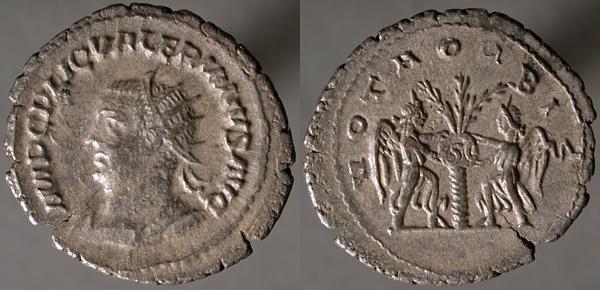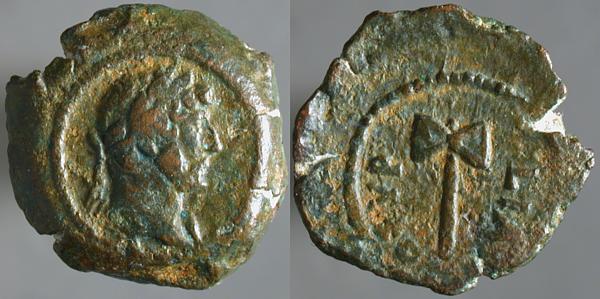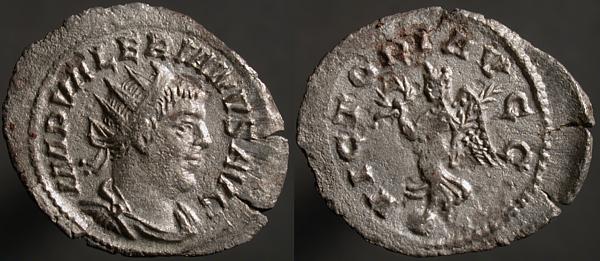Saturday, April 23, 2005
Silvered Æ antoninianus, Gallienus, Antioch, Göbl 1666i

GALLIENVS AVG, Radiate draped cuirassed bust right | VIRTVS AVG, Mars standing facing, head right, holding long spear left, leaning on shield right. PXV in exergue.
On Saturday, and Sunday if I need the time, I write the posts for Monday thru Sunday of the coming week. By the time I get to the posts for the end of the week, I often find myself especially short of inspiration, with little to say. Therefore, as every blogger must, sooner or later, I give you a bunny with a pancake on his head.
Friday, April 22, 2005
Æ29, Tyre in Phoenicia, Valerian, BMC 465

IMP C P LIC VALERIANVS AV, Radiate draped cuirassed bust right | COL TVRO MET, River-god or lake-god, nude to the waist, standing facing, head left, holding long-leafed plant right, hand on uncertain object (cuirass?) left, (river-god swimming beneath?), murex shell in left field.
The only catalog I own that lists this coin is from nearly 100 years ago, but it seems that the object remains uncertain.
Thursday, April 21, 2005
Billon antoninianus, Valerian, Samosata, Göbl 1682f

IMP C P LIC VALERIANVS AVG, Radiate cuirassed bust left | VOTA ORBIS, Two victories fixing shield inscribed SC to palm tree.
I like this one, it's the clearest example of this reverse I have. Could be a bit sharper on the obverse, but life's a series of compromises, and on balance I'm quite satisfied. The grey toning is nice, too, suggesting that this has been out of the ground, and among collectors, for some time.
Wednesday, April 20, 2005
Æ Dichalkon, Hadrian, Oxyrhynchite nome, 128/129 CE, Emmett 1283(11)
Æ Dichalkon, Hadrian, Oxyrhynchite nome, 128/129 CE, Emmett 1283(11)

Laureate head right | OΞYP LIA, Bipennis
Recent successes at Oxford in reading the Oxyrhynchus Papyri, found in an ancient garbage dump, have been the talk of blogs both classical and general during the last week. While it seems that all coins of Roman Egypt were minted at Alexandria, some of them named a Nome, though I know of no reason to believe that they were only current in that city.
In any case, this rather crude little coin names Oxyrhynchus, where the papyri were found.

Laureate head right | OΞYP LIA, Bipennis
Recent successes at Oxford in reading the Oxyrhynchus Papyri, found in an ancient garbage dump, have been the talk of blogs both classical and general during the last week. While it seems that all coins of Roman Egypt were minted at Alexandria, some of them named a Nome, though I know of no reason to believe that they were only current in that city.
In any case, this rather crude little coin names Oxyrhynchus, where the papyri were found.
Tuesday, April 19, 2005
Æ35, Carallia in Cilicia, Valerian, SNG Levante 370

AV KAI Π ΛΙΚ OVAΛEPIAON EV, Laureate draped cuirassed bust right, H before | KAPA;_Λ_ΛIΩTΩN, Athena standing facing, head left, holding tiny Nike left. Athena leans on shield and spear right.
Although Carallia (near the site of Beysehir, Turkey) was in Cilicia, this coin seems to me more like those of Pamphylia. The obverse, in fact, seems like a copy of this one from Aspendos.
The flan is unusually thin, yielding a coin of greater diameter, 35mm, than neighboring cities were producing at this time, rarely over 31mm, from about the same amount of bronze.
Monday, April 18, 2005
Billon antoninianus, Valerian, Antioch, Göbl 1602avar...
(VICTORIA AVGG)

IMP VALERIANVS AVG, Radiate draped cuirassed bust right | VICTORIA VGG, Victory standing on globe facing, head left, holding wreath left and transverse palm to right.
Errors aren't especially uncommon on Roman coins, which were produced, sometimes in very large quantities, entirely by hand. Göbl attests only a single example of 1602a (like this, with the correct VICTORIA AVGG legend), so it's notable that this die, with error, existed.
Was this issue produced in larger numbers than there's evidence today for and, if so, where'd they go? The short legend argues for a date late in Valerian's reign, and Antioch was the jumping-off point for Valerian's unlucky last campaign. Might many of these gone east with him, with no chance of return?
Well, probably not, but it's fun to speculate.

IMP VALERIANVS AVG, Radiate draped cuirassed bust right | VICTORIA VGG, Victory standing on globe facing, head left, holding wreath left and transverse palm to right.
Errors aren't especially uncommon on Roman coins, which were produced, sometimes in very large quantities, entirely by hand. Göbl attests only a single example of 1602a (like this, with the correct VICTORIA AVGG legend), so it's notable that this die, with error, existed.
Was this issue produced in larger numbers than there's evidence today for and, if so, where'd they go? The short legend argues for a date late in Valerian's reign, and Antioch was the jumping-off point for Valerian's unlucky last campaign. Might many of these gone east with him, with no chance of return?
Well, probably not, but it's fun to speculate.
Sunday, April 17, 2005
Æ tetradrachm, Alexandria in Egypt, Salonina, Emmett 3852(14)

KOPNHΛIA CAΛωNEINA CEB, Diademed draped bust right | LIΔ, Eagle standing left, wings open, wreath in beak. Palm in right field, regnal year in left field.
With imagination failing, I end this week as I did last week, with an Alexandrian tetradrachm in the name of Salonina, from the 14th year of her husband's reign, this featuring an open-winged eagle, a pose not much different from those used centuries before at Alexandria during the Hellenistic reign of the Ptolemies (and their sisters and wives, the Cleopatras.)

